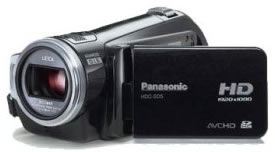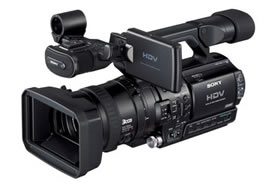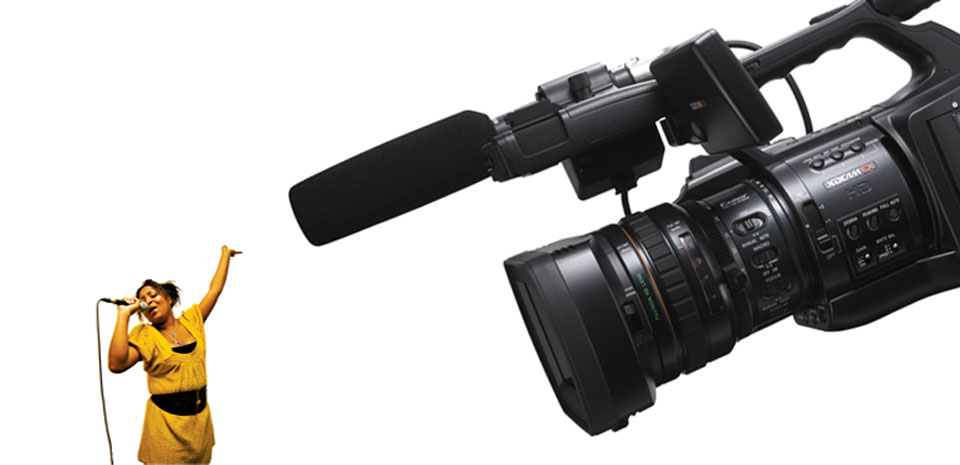A Panasonic ACVHD consumer camcorder

One thing is for sure, HD is the future and unless you are planning low res internet delivered video only, or are on a budget, you should be thinking about buying and using HD technologies.
A top of the range Red camera

Hi-def consumer camcorder models
If you want to make video but are not a professional, here are a few useful pointers to consider when buying a camcorder ...
- Your video editing software must be able to handle the codec/file format your camcorder creates so check before you buy
- Also research the minimum specification for an editing system, some file formats/codecs can be very challenging for a desktop PC or Mac without additional hardware acceleration
- Range of recording media includes, tape, hard drive and memory cards
- Camcorders that record to DVD should be avoided if they use the old MPEG2 codec/file format
- Its a good idea to buy a camcorder that can record at the full 1920w x 1080h resolution
- CCD is being replaced by CMOS which work better under low light conditions.
- If you do buy a CCD model, single CCD models have vastly inferior colour fidelity to 3 CCD one.
A word about DSLR's
Unless you've been living in a cave it can't have escaped your notice that many Digital SLR's offer a HD video recording mode and many video makers a choosing them in preference to a video camcorder. Here's some pros and cons ...
| DSLR's | |
|---|---|
| Pros | Cons |
CCDs are typically larger than camcorders, therefore ...
|
|
Sony Z1 HDV camcorder

Camcorder/camera round-up (Oct 2010)
The following table shows most of the primary current camcorder technologies in rough order of quality (worst at top). Individual manufactures have developed a wide variety of file format, storage and codec "types". Because a camcorder/camera is where video is first captured and compressed, the codecs they use often determine the codec used throughout the complete edit.
| Type | Record medium | Codec | Data rate (max) | Res-olution | CCDs | Edit on PC/Mac? | Comments |
|---|---|---|---|---|---|---|---|
| Consumer - standard def | |||||||
| Consumer - DVD | DVD | Meg-2 | - | PAL & NTSC interlaced | 1 & 3 CCDs | No | Pros ... Useful if you want to watch recordings immediately on your DVD player & TV. Cons ... can't easily transfer to a computer to edit. |
| Consumer - Flash memory | Flash memory cards | Mpeg-2 / Mpeg-4 | - | 640x480 interlaced | 1 CCD | Yes & no | Pros ... Compact, easy to transfer but low quality and not compatible with all editing software |
| Consumer - Hard disk | Hard drives | Mpeg-2 | - | PAL & NTSC interlaced | 1 CCD | Yes but awkward | Pros ... Non linear access to recordings. Good quality. Cons ... Awkward to transfer. |
| MiniDV (up to £500) | MiniDV tape cassette | DV | 210Mb per min | PAL & NTSC interlaced | 1 CCD | Yes | Pros ... Good tried and tested format. It works! Computers fast enough now to offer real time rendering. Great compatibility. |
| MiniDV (over £500) | MiniDV tape cassette | DV | 210Mb per min | PAL & NTSC interlaced | 3 CCD | Yes | Pros ... Good tried and tested format. It works! Computers fast enough now to offer real time rendering. Great compatibility. Great colour fidelity. |
| Prosumer - standard def | |||||||
| DV-Cam | DV-Cam and MiniDV tape | DV | - | PAL & NTSC interlaced | 3 CCD | Yes | Pros ... Good tried and tested format. It works! Computers fast enough now to offer real time rendering. Great compatibility. Great colour fidelity. Robust tape format. |
| DVC-Pro | DVC-Pro tape | DV & high quality mode | - | PAL & NTSC interlaced | 3 CCD | Yes | Pros ... Good tried and tested format. It works! Computers fast enough now to offer real time rendering. Great compatibility. Great colour fidelity. Robust tape format. Broadcast quality. |
| Pro-sumer - hi def | |||||||
| DSLRs | Memory card | MOV (Video: H.264 / MPEG-4 AVCSound: 16-bit linear PCM at 48khz) | 48Mbps | 1920×1080 (1080p, Full HD, High Definition, 24p) | CMOS | Yes | Many manufacturers are adding HD video capabilities to their stills cameras and many can offer image quality comparable or greater than entry level camorders albeit with limited sound and accessory options. |
| AVCHD (Advanced Video Codec Hi Definition) | Memory cards & hard drive | MPeg-4/H.264 | 17-36Mbps | 1920x1080 | 1 & 3 | Yes | Excellent cost effective entry level prosumer Sony/Panasonic format supported by Final Cut Pro. Used for Blu-Ray, Sky etc |
| AVCCAM / NXCAM (Panasonic & Sony) | Memory cards | AVC | 24Mbps | 1920x1080 | 3 large chip | Yes | Good for low budget shoot. |
| HDV (Sony & JVC) | DV tape sized tape & MiniDV tape | MPeg2 | 19-25Mbps | 1440x1080 | 1 & 3 | Yes | Most popular camcorder is Sony Z1. Not really good enough for hi-prod value stuff like drama, but is used by BBC for news gathering, wildlife and documentaries. |
| Professional - hi def broadcast | |||||||
| XDCAM (Sony) | Optical discs and memory cards | MPeg2 | 25-50Mbps | 1440/1920 x1080 | - | Yes with intermediate codec | Entry level true broadcast quality. |
| DVCProHD (Panasonic) | Memory cards | AVC intro | 100Mbps | 1920x1080 | - | Yes with intermediate code | Used by BBC |
| HDCAM (Sony) | Tape cassette | MPeg2/4 | 144Mbps | 1440/1920 x1080 | - | Yes with intermediate code | Used by BBC |
| Professional - hi def broadcast and film | |||||||
| Red | Memory card | Redcode / Wavelet | 336Mbps | 4096x2304 | - | Yes with intermediate code | Superb quality, awkward transcode/edit process |
| Arri | Hard drive | ArriRAW / Apple ProRes 422HQ, 4444 or uncompressed | 3Gbps | 2880x1620 | - | Yes with intermediate code | |

